Garden Paths to Crime
As the last leaves fall it may seem odd to choose gardens as our theme for November. But, if you have just finished gathering your apples, are thinking of planting new trees and shrubs, or simply looking forward to spring, it may not be such a surprise.
We have two cases this month both unfortunately of gardens being severely damaged.
In 1844 the very appropriately named William Peat and Robert Appleby, both aged 19, were accused of extensive damage to trees and plants at Captain Moore's garden at Maulden. The deposition gives detail of the plants enabling us to build up a picture of the garden (QSR1844/2/5/11-12).
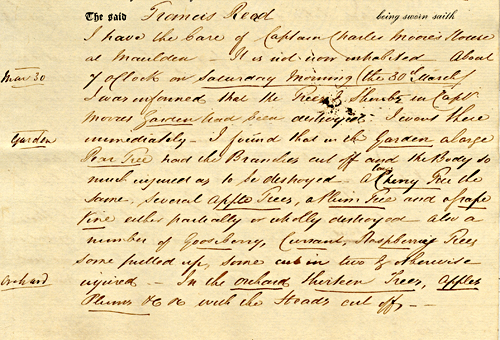
It goes on to say "In the orchard 13 trees, apples plums etc had the heads cut off. In the pleasure ground he found a fine red cedar cut to within a few inches of the ground; an arborvitae with the head cut off; a great number of standard roses and other ornamental trees and shrubs either cut off, pulled up or otherwise destroyed; and a great quantity of flowers pulled up."
Charles Moore, the youngest son of the vicar of Thurleigh, was a captain in the Royal Navy. In 1824 he purchased Maulden Cottage. The cottage was at Hall End, Maulden bordering with Clophill. The property in 1824 is described as 'messuage or tenement with several yards gardens and appurtenances…and also all that close piece or parcel of meadow or pasture land lying on the south side of the said messuage and other premises now in the occupation of Charles Moore with the plantations, shrubberies and pleasure grounds thereunto belonging and surrounding or enclosing the same…containing together four acres three roods and thirty three perches…bounded on the north by the road leading from Ampthill to Clophill and Shefford on part of the east by the homestall and buildings of the Flying Horse public house in the parish of Clophill'(CCE689/21). The plot is shown on deed CCE689/3:
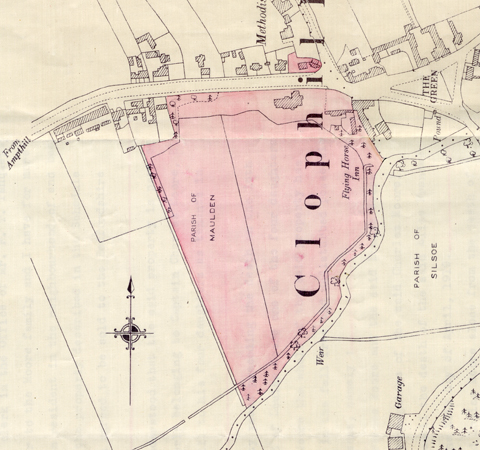
This last part of the description may be significant as the two culprits had been drinking in the Flying Horse the evening before the garden was damaged, although the witness, William's brother, said they all left the Flying Horse at 9.30 and he later parted with them at Smith's beerhouse. There is nothing in the evidence to suggest a motive for the crime, although it appears that drink may have been a factor and Robert had been in trouble twice before, and the first time Charles Moore had been the magistrate. The pair were found guilty on the evidence of foot prints and a branch of cedar that they tried to burn in fire at The Compasses public house the following morning.
Charles Moore had four daughters, Eliza, Maria, Emily and Louisa. However, at the time of the damage the house was unoccupied and it is likely that the family were stationed abroad as they do not appear on the 1841 or 1851 census. The three eldest girls were born at Maulden but Louisa was born in Aldeburgh in 1836. Emily married John Stone, the curate of Barton-le-Clay in 1859 but her sisters remained single. The family may have returned to Maulden Cottage on the Captain's retirement as he and his unmarried daughters are living there at the time of the 1861 census. Captain Moore died on the 10 November 1870. There is a memorial to his wife, Elizabeth Anne (d. 1857) and himself in Maulden churchyard. On his death the property passed to his daughters and was finally sold by Louisa's executors in 1933 being then described as 'an old fashioned country residence' with an excellent garden (AD1147/96):
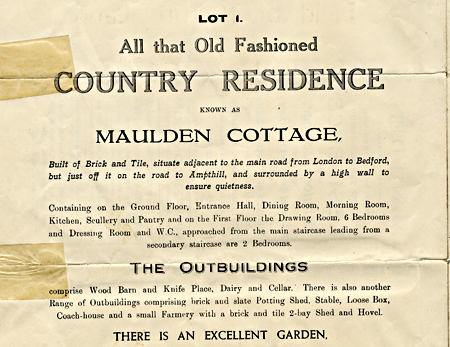
It was purchased by Bedfordshire County Council. The house seems to have then been demolished and a police house put in its place, although the gardens appear to have remained largely intact. The site of the police house was sold in 1996 and it is believed that the police house was then replaced with the present house. (CCE689/44):
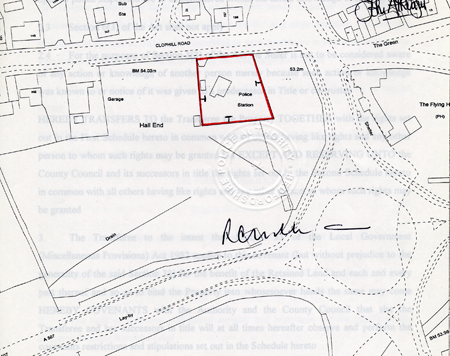
But what of William Peat and Robert Appleby? According to our gaol database William was sentenced to 7 years transportation and Robert to 14 years. Robert was sent to Van Dieman's Land on the vessel William Jardine. William Peat set sail for Van Dieman's Land ten months later but died on the voyage on the 13 September 1845. http://www.sellingsparrows.com/index.htm
Now let us turn to our other case. In 1856 the garden of Joseph Tucker at Pavenham Bury was damaged. Once again we are given a tremendous amount of detail about the plants that grew in the garden, which was surrounded by a wall 12 or 14 feet high. (QSR1856/4/5/12a):
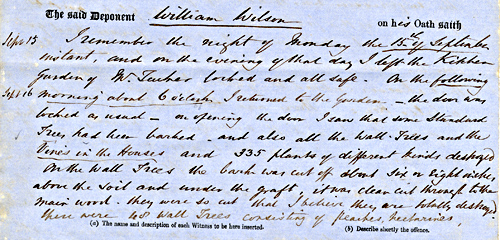
This time there was a single culprit, Robert Toll (QGV10/4p60):
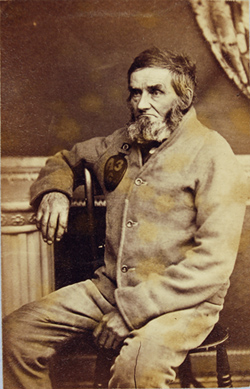
Toll was identified by his footmark and the pattern of his corduroy trousers in the soil and by his left handedness. Robert had worked his own fruit trees on land owned by Joseph Tucker and worked as a gardener in the village so knew how to injure trees enough to kill them. He had recently been given notice to quit Tucker's land. However, the most telling thing against him was that several witnesses said they had heard him speak against Mr Tucker. The case descends into farce when Toll, who according to the gaol register is 59, slightly built and has seven children, is remanded in custody for the night and handcuffed and chained to a bed at The Swan, Sharnbrook. At 3 am the policeman is informed that the prisoner has escaped. He is quickly found at the home of his daughter and son in law in Pavenham where the daughter is still holding the hatchet she has been using to break the handcuffs.
Strangely perhaps Robert is found not guilty of the damage to the trees but is found guilty of stealing a pair of trousers, a pair of braces, a jacket and a pair of shoes from the servant at The Swan in order to make his escape (QSR1856/4/5/12b).We presume that the servant was also slightly built otherwise Toll would surely have been hampered in his escape by clothes that were too big for him!
Toll received a sentence of 4 years penal servitude, perhaps partly due to his three previous convictions, and is sent to Millbank prison. In 1863 he once again appears on the Bedford gaol database, this time for the theft of barley and is sentenced to 10 years, so back he goes to Millbank. Robert died in 1871 while living with the daughter who had wielded the hatchet.
Joseph Tucker bought Pavenham Bury by private treaty in November 1852; the gardens are described on the sale catalogue of 1851 (AL369):

We are fortunate to have a photograph of Joseph Tucker in a photograph album kept by the Orlebar family of Hinwick (OR2386/1P19):
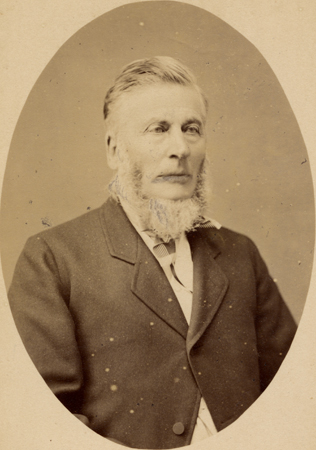
By the time this photograph of Pavenham Bury was taken by Sweetland in about 1908 the gardens had recovered. (Z1130/87):
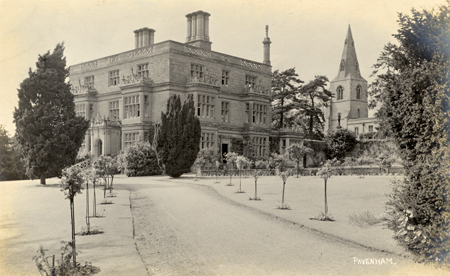
The scale of the destruction and the severe sentencing is what sets these two cases apart from other garden related crimes. In 1822 Andrew Chambers was fined 6 shillings for damaging apple trees belonging to John Austin of St Peter's Bedford and in the same year Joseph Keep served three months in gaol for injuring a crop of apples. (BorBF4/67/106):

However, the more usual fruit related crime was, of course, theft. In 1859 this reward was offered for stolen apples (X67/648):
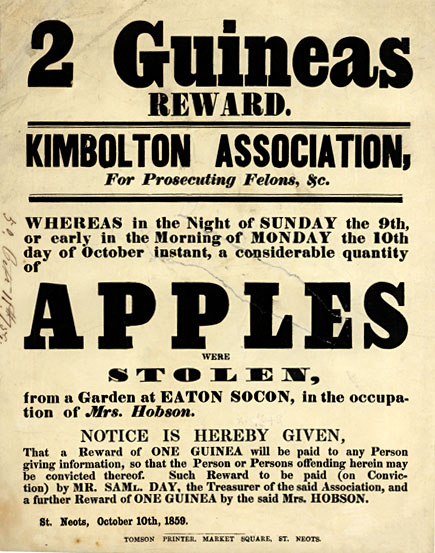
At the time apples were worth about 2 shillings a bushel, so this reward seems generous.
Perhaps not surprisingly the culprits in apple thefts were often young boys such as Albert Cox and Samuel Albone both aged 11 who stole apples from Miss Hailey's orchard in Arlesey in August 1877. Three older boys were also convicted. Miss Hailey decided to prosecute because she didn't have many apples that year. (HF147/10/1627):
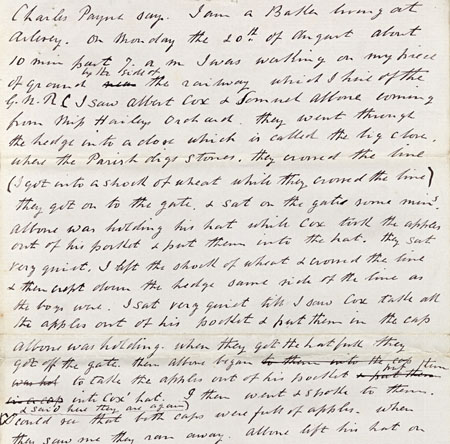
They were sentenced to a day of imrisonment and to be whipped with six strokes of a birch rod:
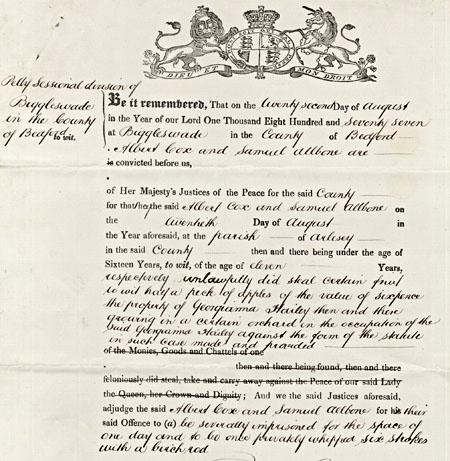
For full details of the case against William Peat, Robert Appleby and Robert Toll search our catalogues.
If you want to know more about researching garden history in the archives click here.
If you would like to know more about Apples in the Archives download this 2007 exhibition leaflet .